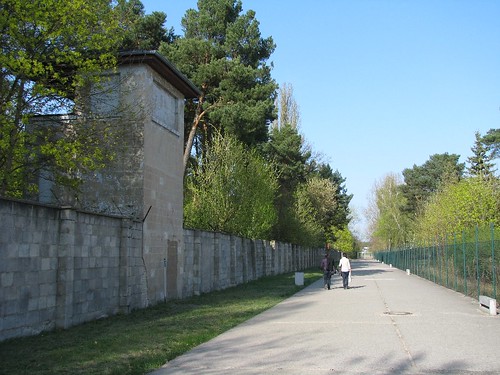Imagine Germany. Imagine a cold day in December. Try now travel back in time and space. To the small town of Oranienburg, north of the Brandenburg region, 30 kilometers from Berlin. Walk now for 20 minutes at minus 15 degrees in temperature, while watching how your feet are sinking slowly in the virgin snow that leads from the tiny train station to your destination, Sachsenhausen, where have you been told that a new hopeful life awaits.

Fotografía por cavorite
Everything may seem idyllic through the door that leads to the wire, where the clock still points to 11 in the morning and flakes of snow fall harmoniously to the rhythm of the needles to mark the passing time, just 70 years ago.
«Arbeit macht frei» (work will set you free), prays at the gate. A house painted pink for women, and a painted green for men, surrounded by flowers. Inside, the showers which it is necessary to undress as if they were paying tribute to «sanitize» our bodies of a virus epidemic that plagues the area. Average life expectancy: 20 minutes. After showers, the horizon of the steppe that never ends, the white snow and silence. The immensity of the blue. Millions of souls for forgiveness and bleeding that have never committed crimes. The horrors of a past not far away and hopefully never again.

Fotografía por rwhgould
Sachsenhausen model:
The Sachsenhausen concentration camp was destined to be the model and the most important of all. From it, the Nazis would manage the rest of satellite camps in Germany, Poland, Holland and Belgium to the image of this, and would expand the way a company the rest of Eastern Europe, obtaining and managing the related revenue all staff.
Some 165 labor camps provided labor to the great German industries. Great German banking firms would finance the construction of these fields and all materials. Others such as IG Farbenindustrie AG, produce the so-called Zyclon B, hydrocyanic acid compound used in the gas chambers for the extermination of millions of people, overwhelmingly Jewish. «There is a way to freedom, but only through the chimney», staff have indicated that SS newcomers to the field pointing to the chimneys of the crematorium. Through the experiences recounted by the survivors of photographs taken by its own SS and documents found in the fields after the end of World War II, we have evidence of the true story of a concentration camp and how through deception both the German and the Jewish population was spending his days on one side and the other of the fence.

Fotografía por robertpaulyoung
More than 6 million victims in concentration camps:
Over 200,000 human beings passed through Sachsenhausen, guided by a fatal destiny. At least 50,000 died in the attempt to survive. The rest perished under forced labor, unbearable psychological torture and temperatures in the region. In total, more than 6 million Jews and thousands of political prisoners, homosexuals and religious of a regime that would not subject the rest of his life. A holocaust, a debacle, a crime irreversible. The chaos and barbarity of human action taken to its fullest, one of the biggest violations of Human Rights which has seen our history. And one of his biggest regrets, those that make us ashamed of being born human.
I return to Berlin on the train watching the same landscape bleak and melancholy that one day should see through his eyes, crowded, those thousands of souls without consolation. The difference is that his trip, probably the first and the last of their lives, was of no return, mine is to tell the tale. Today, several homes and buildings filled with beautiful frozen lakes and forests of ferns remain intact witnesses a white and infinite past, but not again, we must remember that it is present.
Leave a Reply
You must be logged in to post a comment.
Recent Comments